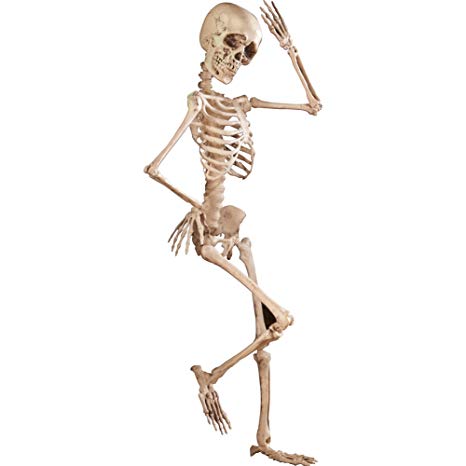The skeletal system is made up of bones for structure, movement, protection, and to produce blood cells in bone marrow.
There are two hundred and six bones in an adult body. Children have more bones that grow into each other. Bones are split into two catagories axial and appendicular. Axial bones are to keep you up right. Appendicular bones are for movement. The skull is a large bone in your head also known as the cranium. It protects the brain and gives structure for your face.
The ribcage protects your lungs, liver and heart. The ribs are in pairs. There are fixed and floating bones in the ribcage. The fixed bones are connected to the sternum and vertebrae. The floating bones are connected to the vertebrae.
The spine is made up of 33 vertebrae to protect the spinal cord.
Pelvis (or hips) are below the spine.
Joints are to help your arms and legs move. There are two types of joints, ball and socket joints and hinge joints. Ball and socket joints are in your shoulders and in your pelvis. Hinge joints are in your elbows, knees, ankles, knuckles, and in your wrists.
Arms and legs are similar in structure. In the arm the higher bone is called the humerus and the two lower bones are the ulna and radius. In the leg the femur in the thigh is the longest bone in the body, the two lower bones are the fibula and tibia.
Drinking milk or dairy products and vitamin D are great ways to keep your bones healthy.
There are two hundred and six bones in an adult body. Children have more bones that grow into each other. Bones are split into two catagories axial and appendicular. Axial bones are to keep you up right. Appendicular bones are for movement. The skull is a large bone in your head also known as the cranium. It protects the brain and gives structure for your face.
The ribcage protects your lungs, liver and heart. The ribs are in pairs. There are fixed and floating bones in the ribcage. The fixed bones are connected to the sternum and vertebrae. The floating bones are connected to the vertebrae.
The spine is made up of 33 vertebrae to protect the spinal cord.
Pelvis (or hips) are below the spine.
Joints are to help your arms and legs move. There are two types of joints, ball and socket joints and hinge joints. Ball and socket joints are in your shoulders and in your pelvis. Hinge joints are in your elbows, knees, ankles, knuckles, and in your wrists.
Arms and legs are similar in structure. In the arm the higher bone is called the humerus and the two lower bones are the ulna and radius. In the leg the femur in the thigh is the longest bone in the body, the two lower bones are the fibula and tibia.
Drinking milk or dairy products and vitamin D are great ways to keep your bones healthy.


 RSS Feed
RSS Feed